
http://www.iaeme.com/IJM/index.as 127 editor@iaeme.com
International Journal of Management (IJM)
Volume 8, Issue 3, May– June 2017, pp. 127–133, Article ID: IJM_08_03_013
Available online at
http://www.iaeme.com/ijm/issues.asp?JType=IJM&VType=8&IType=3
Journal Impact Factor (2016): 8.1920 (Calculated by GISI) www.jifactor.com
ISSN Print: 0976-6502 and ISSN Online: 0976-6510
© IAEME Publication
A STUDY ON ATTITUDE TOWARDS PACKED
READY TO HEAT AND EAT FOOD PRODUCTS
BASED ON HEALTHY FOOD RELATED LIFE
STYLES
Dr. K. Abdus Samad
Director, Jamal Institute of Management
Jamal Mohamed College (Autonomous)
College with Potential for Excellence
Reaccredited (3
rd
Cycle) with ‘A’ Grade by NACC
Tiruchirappalli - 20
Pushkar Narayan Singh
Part Time Research Scholar
Jamal Institute of Management
Jamal Mohamed College (Autonomous)
College with Potential for Excellence
Reaccredited (3
rd
Cycle) with ‘A’ Grade by NACC
Tiruchirappalli - 20
ABSTRACT
In this study, general food choice motives are not considered, instead more specific
attitude towards packed ready to heat and eat food products are predicted based on
specific attitude like health consciousness, environmental attitude and healthy food
related life style. The main objectives of the study are to identify whether environmental
attitude and health consciousness create positive and significant impact on healthy food
related lifestyle. Finally to check whether healthy food related lifestyle creates positive
and significant impact on Attitudes toward Packed Ready to Heat and Eat Food
Products. The sample size for the study is 480 by adopting purposive sampling
technique. The data were collected from selected malls in Bangalore city. The result of
this study shows that two hypotheses were accepted and one hypothesis is rejected.
Key words: Healthy Food Related Life Styles, Environmental Attitude, Health
Consciousness.
Cite this Article: Dr. K. Abdus Samad and Pushkar Narayan Singh, A Study On
Attitude Towards Packed Ready To Heat and Eat Food Products Based On Healthy
Food Related Life Styles. International Journal of Management, 8(3), 2017, pp. 127–
133.
http://www.iaeme.com/ijm/issues.asp?JType=IJM&VType=8&IType=3

A Study On Attitude Towards Packed Ready To Heat and Eat Food Products Based On Healthy Food
Related Life Styles
http://www.iaeme.com/IJM/index.as 128 editor@iaeme.com
1. INTRODUCTION
Changes in the lifestyle of people across the world have increased the demand for convenience
in meal preparation. Olsen, 2010 pointed out that consumers have been working longer hours,
spending more time in the traffic, and longing to maximize their leisure time, which is more
and more limited; they therefore require products and services that support and make their
hectic lives easier. As a reaction to such demand, the food industry has expanded its packed
ready to heat and eat food products in India.
The convenience concept may be applied to different consumption dimensions: a feature
inherent in a product, in the product purchase process, the preparation process and storage of
such product. Convenience food is defined as any food, fully or partially prepared, for which
preparation time, cooking skills or energetic inputs were transferred from the housewife kitchen
to a processing or distributing party (Scholderer, Grunert, 2005).
Buckley (2005) consider there are a number of factors which influence packed to ready to
heat and eat food products and ready meals demanding: aging of population, changes in family
structure, women participation in workforce, longer working hours, consumer prosperity, desire
to proceed to healthy foods, individualism, decrease in cooking skills, and desire to spend less
time and efforts in meal-related activities, such as shopping, preparing and cleaning foods.
Other social-economic and demographic factors which influence this increase in consumption
include work regime, family size, income level, time pressure realized and paper overload
(Verlegh, Candel, 1999).
In recent years, lifestyle factors have become important and are applied widely in describing
how consumers make food decisions (Senauer, 1991). The lifestyle construct has a longstanding
history in marketing research, which describes how people seek to express their identity in
many areas such as activities, interests, and opinions (AIO). However, it has been argued that
a person’s lifestyle need not be consistent across different life domains. Therefore, the lifestyle
should be restricted to certain life domains (Van Raaij and Verhallen, 1994). Within the
narrower lifestyle perspective, health inequalities are mainly the results of people’s choices and
habits concerning health-beneficial (and non-beneficial) everyday behavior such as exercise
habits, smoking and drinking behavior, dietary habits, and so on. In other words, food related
lifestyle choices in which people differ are the main causes of health inequality (Manderbacka,
1999; Sacker., 2001). Therefore, this paper adopts a narrower and operationalizable definition
of the lifestyle, focusing on health-related behavior on the determinants of food (Gil, 2000). A
healthy food related lifestyle emphasizes physical health-related activities such as natural food
consumption, health care, and life equilibrium. It is believed that this healthy food related
lifestyle construct is helpful to explore whether or not a consumer’s attitude toward packed
ready to heat and heat food products influenced by one’s food related lifestyle. Therefore, in
addition to health consciousness and flavor, convenience and tradition, how people seek to
express their identity in the food related life style towards ready to heat and eat food products
is further analyzed in the study.
2. NEED FOR THE STUDY
In this context, the issue characterizing this research is: how do food related lifestyles related
to eating habits influence packed ready to heat and eat food products consumption? In order to
answer this question, researcher identified characteristics of Indian consumers in the city of
Bangalore. Although Indian eating habits have been relatively frequently studied, there are very
few studies conducted in south India. This study expects to contribute with consumer behavior
literature based on perception of Indian Consumers towards packed ready to heat and eat food
products. Bae, Chae and Ryu (2010) identified four factors related to lifestyles regarding ready
meals: health orientation, flavor, convenience and tradition. Therefore this paper mainly aimed

Dr. K. Abdus Samad and Pushkar Narayan Singh
http://www.iaeme.com/IJM/index.as 129 editor@iaeme.com
to identify food related life styles related to packed ready to heat and eat food products
consumption in Bangalore, India.
3. STATEMENT OF THE PROBLEM
Since packed ready to heat and eat food products are marketed as healthier, fresh, tasty,
conventional foods and environmentally friendly, it is of interest to investigate the relationships
between key factors and the consumer’s attitude toward packed ready to heat and eat food
products. Unlike previous studies that use general food choice motives to predict the
consumer’s attitude toward food products, this study adopts more specific attitudes, such as
health consciousness and environmental attitudes, to predict the consumer’s attitude toward
packed ready to heat and eat food products. The main objective of the present study is to test
the hypotheses that health consciousness and environmental attitudes influence a consumer’s
attitude toward packed ready to heat and eat food products through an individual’s healthy
lifestyle. The results might help producers and marketers to design appropriate marketing
promotion strategies for packed ready to heat and eat food products consumption.
4. THEORETICAL FRAME WORK
An attitude is considered as a psychological propensity that is expressed by evaluating a
particular entity with some degree of favor (Eagly and Chaiken, 1995). Values and beliefs are
the core building blocks of attitudes (Verplanken and Holland, 2002). An individual may have
several beliefs toward an object, and in turn, these beliefs and their evaluations together form
an attitude. Previous studies show that causality flows from values through attitudes to
behavior, forming a hierarchical relationship of value-attitude-behavior (Bernard, 2003;
Stienstra., 2002; Thogersen and O lander, 2002). This means that values have an impact on
attitudes, which in turn influence a person’s behavior. The most commonly held beliefs about
packed ready to heat food products are that they are healthier and promise better environmental
protection. Thus, concerns for one’s health and for the environment are the two most commonly
stated factors for purchasing packed ready to heat and eat food products. An individual’s health
consciousness and environmental attitudes are believed to be determinants of his/her attitude
toward packed ready to heat and eat food products. Furthermore, an individual’s healthy food
related lifestyle which emphasizes physical health-related activities may enhance the impacts
of health consciousness and environmental attitudes on their attitude toward packed ready to
heat and eat food products. Thus healthy life style is essential to include in the study. A healthy
life style is considered as health consciousness and environmental attitudes which able to
influence the consumer’s attitude toward packed ready to heat and eat food products.
Lifestyle is an attempt to adapt an individual’s behaviors in such a way as to achieve basic
values throughout life, even though the environment is changing. Therefore, lifestyles change
over time in systematic ways, but not anxiously or randomly so as to make it possible to
maintain the balance between changes in the environment and an individual’s own value
system. This is why food related lifestyle segmentation is often used to predict consumer
behavior for marketing purposes. Due to increasing disposable incomes and busy lifestyles,
people are changing their dietary lifestyle to maintain or improve their health and the
environment. Different from the general food-related lifestyle developed by Brunso and
Grunert (1995) and Grunert (1997), a narrower and operationalizable definition of lifestyle –
i.e. healthy food related lifestyle, which focuses on health-related behavior on the determinants
of health – is adopted in this study.

A Study On Attitude Towards Packed Ready To Heat and Eat Food Products Based On Healthy Food
Related Life Styles
http://www.iaeme.com/IJM/index.as 130 editor@iaeme.com
5. HYPOTHESES
• The consumer’s health consciousness is positively related to healthy lifestyle.
• The consumer’s environmental attitude is positively related to healthy lifestyle.
• The consumer’s healthy food related lifestyle is positively related to attitude towards to packed
ready to heat and eat food products
6. METHODOLOGY
Questionnaires were administrated to 520 respondents, who had accepted to participate in the
research. The respondents were identified based on the purchase done in the selected leading
malls in Bangalore. Customers who had purchased any brand of packed ready to heat and eat
food products are considered as the potential respondents. Out of 520 questionnaires, 485
questionnaires were returned, in which 480 were fully completed.
For the present study, four core construct are considered. The three measurement scales are
associated with study adopted and scale validated by Gil (2000). The remaining health
consciousness is adopted from the study Oudi Ophuis (1989). The health consciousness scale
is operationalized with an 11-item scale to assess the degree of readiness to undertake health
actions. Environmental attitude is measured by a five-item measurement scale concerning self-
reported environmentally friendly attitudes and behavior. A nine-item measurement scale
describing the general public’s concerns about the attributes of the packed ready to heat and eat
food products is used to measure the consumer’s attitude toward packed ready to heat and eat
food products. An 11-item measurement scale describing an individual’s ways of living related
to health is used to measure his/her health lifestyle. According to Gil et al. (2000), there are
three sub-dimensions in a healthy lifestyle: (1) natural food consumption;
(2) health care; and (3) life equilibrium. Respondents are asked to rate all of the five-point
Likert scale questions, with 1 indicating strong disagree and 5 indicating strong Agree. The
statistical analysis like correlation and multiple regressions were done to check the hypotheses
developed for this study with the help of statistical package SPSS.V 21.
7. RESULT AND DISCUSSION
Reliability can reflect the internal consistency of the indicators measuring a given construct.
Therefore, before the hypotheses are tested, the reliability of the measurement scales should be
checked. In general, the reliability of the construct should be greater than 0.7 (Cronbach, 1951)
in order to meet with the general requirement of reliability for research instruments. All the four
dimensions were above 0.7. The composite reliability of all the four dimensions was above 0.5,
and the average variance explained by all the dimensions was above 0.7. Thus the data collected
attained reliability and validity.
In this study, majority of the respondents are male (68%), majority of the respondent’s age
group lies between 25 – 35 years (42%), majority of the respondents monthly income lies
between Rs.40, 000 to 60,000 (30%), majority of the respondents are married (39%).
(i) Descriptive Statistics
N Mean Std. Deviation
Environmental Attitudes
480
4.03 .863
Health Consciousness 4.18 .811
Healthy Lifestyle 4.19 .799
Attitudes toward Packed Ready to
Heat and Eat Food Products 4.15 .843

Dr. K. Abdus Samad and Pushkar Narayan Singh
http://www.iaeme.com/IJM/index.as 131 editor@iaeme.com
The descriptive statistics shows that the mean value is high for healthy life style dimension,
and the standard deviation is low (.799). Health consciousness takes the second highest mean
values (4.18) with second lowest standard deviation (.811) followed by attitudes towards
packed ready to heat and eat food products. The dimension environmental attitudes takes the
lowest mean value (4.03) while comparing with other dimensions, and highest standard
deviation (.863), while comparing with other dimensions.
(ii). Correlation
Environmental
Attitudes
Health
Consciousness
Healthy
Lifestyle
Attitudes toward
Packed Ready to
Heat and Eat Food
Products
Pearson Correlation .567
**
.729
**
.750
**
Sig. (2-tailed) .000 .000 .000
N
480 480 480
The correlation table shows that respondent’s attitude towards packed ready to heat and eat
food products is highly correlated (.750) with healthy food related lifestyle and it is significant
at (.001) level. Respondent’s attitude towards packed ready to heat and eat food products is
highly correlated (.729) with healthy consciousness and it is significant at (.001) level.
Respondent’s attitude towards packed ready to heat and eat food products is highly correlated
(.567) with environmental attitude and it is significant at (.001) level.
(iii). Multiple Regression
Model
Unstandardized
Coefficients
Standardized
Coefficients t Sig.
B Std. Error Beta
1
(Constant) .069 .126 .549 .583
Environmental Attitudes .063 .037 .060 1.715 .087
Health Consciousness .430 .039 .414 10.970 .000
Healthy Lifestyle .485 .029 .497 16.698 .000
R Value .842 R
2
.708
F : Sig 385.620 .000 Adjusted R
2
.707
Dependent Variable: Attitudes toward Packed Ready to Heat and Eat Food Products
The dimensions Environmental Attitudes, Health Consciousness and Healthy food related
lifestyle are considered as the predictors of Attitudes toward Packed Ready to Heat and Eat
Food Products. The strength of relationship among the four dimensions is very high. The
predictors predicted 70.8% of attitudes toward Packed Ready to Heat and Eat Food Products.
The Beta columns reveal that healthy life style (.497) is the strongest predictor of attitudes
toward Packed Ready to Heat and Eat Food Products, and it is highly significant. The second
highest beta value (.414) is taken by the dimension Health Consciousness and it is significant
at (0.001) level. The environmental attitude of the respondents beta value is positive (0.60), but
very mild and it is not significant. Based on the results of the multiple regression, out of three
hypotheses formulated, one hypothesis is reject, and the remaining two hypotheses are
accepted. The hypothesis consumer’s environmental attitude is positively related to healthy
food related lifestyle is rejected based on the beta value and significant value. The remaining
hypotheses The consumer’s health consciousness is positively related to healthy food related
lifestyle and consumer’s healthy food related lifestyle is positively related to attitude towards
to packed ready to heat and eat food products are accepted based on the beta value and
significant value.



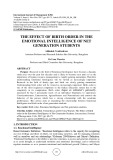
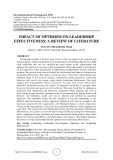
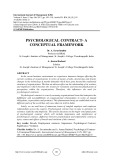
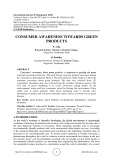
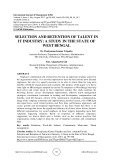

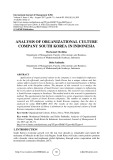
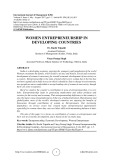


![Câu hỏi ôn tập Tâm lý học quản lý [chuẩn nhất]](https://cdn.tailieu.vn/images/document/thumbnail/2025/20251125/hathunguyen04er@gmail.com/135x160/25191764124376.jpg)
![Cẩm nang chăm sóc và nuôi dạy trẻ tăng động giảm chú ý [chuẩn nhất]](https://cdn.tailieu.vn/images/document/thumbnail/2025/20251118/kimphuong1001/135x160/4241763431998.jpg)


![Sổ tay Hướng dẫn tự chăm sóc trầm cảm [chuẩn nhất]](https://cdn.tailieu.vn/images/document/thumbnail/2025/20251029/kimphuong1001/135x160/3711761720335.jpg)
![Đề cương Tâm lý học xã hội [chuẩn nhất]](https://cdn.tailieu.vn/images/document/thumbnail/2025/20251028/c.dat0606@gmail.com/135x160/99271761707421.jpg)
![Câu hỏi ôn thi Nhập môn khoa học nhận thức [chuẩn nhất]](https://cdn.tailieu.vn/images/document/thumbnail/2025/20251021/aduc03712@gmail.com/135x160/48471761019872.jpg)

![Đề cương môn Tâm lý học sinh tiểu học [chuẩn nhất]](https://cdn.tailieu.vn/images/document/thumbnail/2025/20251007/kimphuong1001/135x160/51781759830425.jpg)



![Tâm lí học lứa tuổi và sư phạm ở tiểu học: Bài thuyết trình [chuẩn nhất]](https://cdn.tailieu.vn/images/document/thumbnail/2025/20250918/vuhoaithuong14@gmail.com/135x160/90941758161117.jpg)
